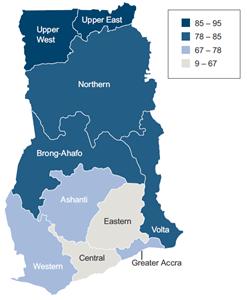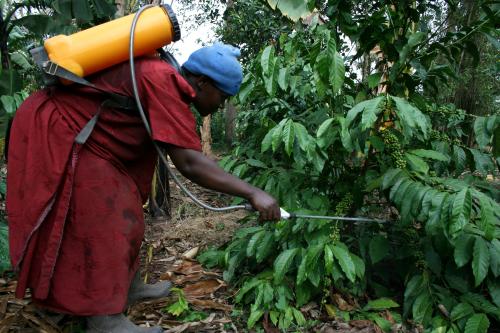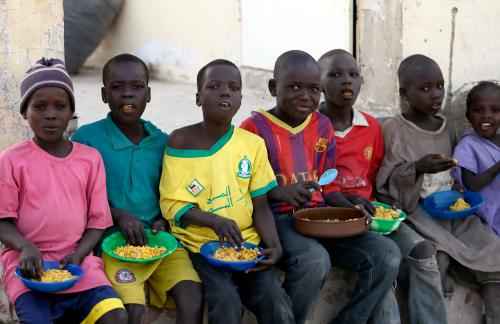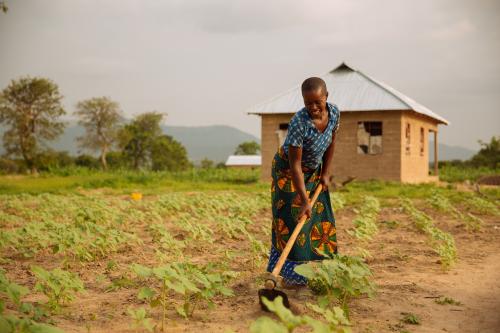This blog is one of a six-part series celebrating World Food Day and highlighting the particular food and nutrition security challenges faced by African nations through six case studies in the Brookings Global Ending Rural Hunger project. The findings summarized below can be found in more depth in the Ending Rural Hunger Ghana case study. The other case study countries include Uganda, Nigeria, Tanzania, Senegal, and Ethiopia.
While 6 million Ghanaians (21 percent of the population) live in rural poverty, when it comes to food and nutrition security (FNS) the country performs relatively better than its African neighbors. For example, according to the Brookings Ending Rural Hunger database, only 4 percent of Ghanaians are likely to be exposed to undernourishment, compared to the region’s 20 percent. Only 51 percent of Ghanaians lack enough money to buy food, compared to 54 percent of people in the region. Average dietary energy supply adequacy, which is the dietary energy supply as a percentage of the average dietary energy requirement, is 142 percent compared to the African average of 114 percent. When it comes to malnutrition, Ghana also has lower rates of under-five wasting and stunting than the region as well (Figure 1). And on a global level, Ghana ranks 27 out of 115 developing countries when it comes to the calorie gap.
Figure 1. Select FNS indicators in Ghana and Africa

There are some indicators, though, in which Ghana performs poorly. For instance, Ghanaians get 66 percent of their calories from staples compared to 62 percent of Africans, signaling a poor diversity in diet. Anemia is another key FNS challenge for Ghana with performing worse than average, as 76.5 percent of children under five nationally have anemia (88 percent in the northern Ghana) compared to the sub-Saharan African average of 60 percent. Anemia in the early stages of life leads to severe negative consequences on development of children even after treatment. The result is a negative effect on human capital and, consequently, the future sustainability of economic growth.
While Ghana performs better than the African average on undernourishment, stunting, and wasting, concentrated pockets of these still exist in Northern Ghana. But when we compare Ghana to the African average, Ghana is in a much better position in relation to food and nutritional security.
Economic growth, but not equal and not in the agriculture sector
Buoyed by the rise in commodity prices throughout the past decade and half, a prosperous mining sector and the discovery of petroleum in 2007, economic growth in Ghana averaged 5.4 percent between 2000 and 2010 and grew to 7.1 percent between 2010 and 2016. During the same period, a 73 percent increase in per capita income has moved Ghana into the lower-middle-income country (LMIC) status. Moreover, the percentage of the population living below extreme poverty has fallen from about 48 percent in 1991 to 12 percent in 2012. These overall increases in per capita income, and its resulting poverty reduction, however, obscure the unequal sharing of the benefits of growth to those facing food and nutritional security challenges.
Evidence from developed countries, including in Asia and Latin America, strongly suggests that agriculture can be an engine of growth early in the development process and also an important force for poverty reduction and FNS. While agricultural growth has been the precursor to the acceleration of industrial growth in a number of emerging economies, in the case of Ghana (as well as most sub-Saharan countries), current agricultural productivity is low—partially contributing to the country’s remaining pockets of poor FNS outcomes. Despite the high percentage of households engaged in agriculture (Figure 2), productivity remains low. Adoption of inputs such as fertilizer, irrigation, and improved seeds remains low due to inefficiencies of output and input markets such as land, labor, credit, and insurance markets. Only 0.7 percent of land is equipped for irrigation, against 12 percent at the regional level and 29 percent at the developing world level. It has been shown elsewhere (such as in Sierra Leone) that alleviating these constraints could result in technology adoption that will improve FNS outcomes.
Figure 2: Percentage of households engaged in agriculture

Agriculture sector policies to address FNS
On the policy side, Ghana has strived to address FNS issues. On the larger scale, Ghana has implemented the Medium-Term Agriculture Sector Investment Plan (METASIP) 2011-2015, which seeks to enhance food security and emergency preparedness to transform the country’s agricultural sector. The METASIP aligns with the regional Maputo Declaration, in which countries agreed to allocate at least 10 percent of their national budget to the agricultural sector. METASIP includes a government allocation of at least 10 percent of the national budget, in conformity with the Maputo declaration. Already, a 2014 study on the perceived impact of METASIP found that the program had a positive impact on productivity improvement as access to fertilizer, seeds quality, and information on market conditions improved. However, challenges still exist: Study respondents highlighted challenges such as the poor adaptability of the machines to local conditions.
On a smaller scale, Ghana had put in place the block farms program, which aimed to improve food security through the use of science and technology. The program provided farmers with subsidized mechanization services and inputs. The program led to increased productivity in maize, rice, and soybean. By 2010, all 10 regions of Ghana were participating in this program, and more crops had been added, including sorghum, tomato, and onions. Another example of a small-scale program intervention is the fertilizer subsidy program of 2008-2016, which aimed to increase farmers’ fertilizer use through voucher programs, leading to increased fertilizer application rate.
A number of donors, such as the U.S., have supported the country’s efforts to address residual FNS concerns, especially in the north of Ghana where FNS conditions are poorest. One successful intervention, partially funded by Feed the Future, is the Home-Grown School Feeding Program (HGSFP). A randomized control trial of the program conducted by Partnership for Child Development found that participation in agriculture increased by about 5 percent in HGSFP communities, the value of own food consumed increased for households in HGSFP communities by 1,729 Ghanaian cedi ($450), net enrollment at the kindergarten level increased by nearly 11 percent, and the probability of stunting among.
Ghana was also among the first six countries to benefit from the social protection “graduation program” funded by donors such as the U.S. Agency for International Development, which provided “ultra” poor households with a productive asset, training, regular coaching, access to savings, and consumption support. The intervention improved both household food consumption and food security with a positive rate of return of 133 percent.
Finding innovative financing and new resources for FNS as Ghana becomes middle income
Despite these successes, Ghana faces a new challenge: It must find innovative sources of finance to help support these types of programs as becoming a LMIC decreases its access to donor-funded FNS programs. Mobilizing internal resource will become a key tool for raising the necessary resources to meet FNS needs, and Ghana must redraft its aid management policy. In the case of Ghana, extensive work has begun to merge in the area of restructuring the processes of the domestic tax divisions in an effort to maximize internal resources capture. But further work still needs to be done. Ghana needs to work with traditional FNS donor partners to provide clarity about their strategies, timeline, and the implications. Further question for consideration include: How will any phasing out be managed to ensure that development gain previously obtained through donor funds are sustained, particularly in the FNS sectors where donors have played a key role? Are there experiences with LMIC graduations in other continents that can guide Ghana’s transition?






Commentary
Enhancing food and nutrition security in a newly middle-income country: Ghana’s unique challenge
November 30, 2017